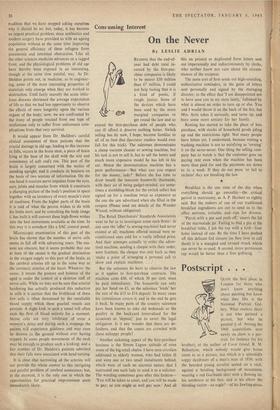Mind and Body
The Stumblers
By JOHN LYDG ATE all fall down. Not very often, but the startling unpleasantness of a heavy fall is a sharp reminder of the self
1) effacing miracle of the
jiI- upright posture. In. a thoughtful article in a recent issue of the British Medical Journal, Dr. J. H. Sheldon considers why this miracle should become so fickle in old
age. He investigated the clinical details of 500 patients over the ageuf sixty whose falls brought them to medical attention; and his report shows how gravity stalks the ageing patient, toppling the eighty-year-olds four times more often than just under sixty— a crescendo of stumbles that must be one of the most unnerving features of old age.
Of his 500 cases about one-third were due to easily recognised external causes —missing the
last step, sliding on slippery surfaces and the like. These are obstacles which everyone meets. Why do the old find them such a problem? Dr. Shel- don has shown that the difficulty really arises once the stumble is under way. Failing vision and so on, causing the patient to miss his footing in the first place, seem to play a relatively small part: the old person's problem is not so much one of avoiding trips as of being unable to prevent trips from turning into full-scale tumbles. A young person can extricate himself by the rapid and quite unconscious recruitment of a set of righting reflexes which are neatly stacked up in the nervous system ready for such emergen- cies. Dr. Sheldon indicates that age somehow dishevels this neat stack of safety devices, so that the correct response is' never quite at hand when needed in a hurry. By the time the brain has sorted out this shuffled pack the old man is as often as not flat on his back. As one of Dr. Sheldon's own patients put it very poignantly, 'Once you're going you've got to go.'
This unsteadiness is now such a well-worn
tradition that we have stopped asking ourselves why it should be so; but, today, it has become an urgent practical problem, since antibiotics and modern surgery have provided us with an ageing population without at the same time improving the general efficiency of these refugees from pneumonia and intestinal obstruction. Like all the other sciences medicine advances on a ragged front, and the physiological problems of old age have thereby been exposed in an interesting, though at the same time painful, way. As Dr. Sheldon points out, in medicine, as•in engineer- ing, some of the most interesting properties of materials only emerge when they are worked to destruction. Until fairly recently the acute infec- tious diseases shortened the average expectation of life so that we had less opportunity to observe the effects of mere longevity upon the various organs of the body; now, we are confronted by the irony of people rescued from one type of misfortune only to suffer from unforeseen com- plications from that very survival.
It would appear from Dr. SheIdon's careful clinical assessment of these patients that the crucial damage in old age, leading to this increase in falls, occurs in the brain stem, a piece of brain lying at the base of the skull with the size and consistency of soft cod's roe. This part of the brain is largely concerned with the tactics of standing upright; and it conducts its business on the basis of two sources of information. On the one hand it receives nerve impulses from the eyes, ears, joints and muscles from which it constructs a changing picture of the body's position in space together with an inventory of every muscle's state of readiness. From the higher parts of the brain it is told of what the person wishes to do with his limbs next; and by consulting the body image it has built it will convert these high-flown wishes into the best movements available at the time. In this way it is somehow like a SAC control panel.
Microscopic examination of this part of the brain has shown that the number of nerve cells seems to fall off with advancing years. The rea- sons are obscure, but it seems probable that one at least of the causes is the gradual diminution in the oxygen supply to this part of the brain, as the cerebral arteries silt up in the same way as the coronary arteries of the heart. Whatever the cause, it means the posture and balance of the aged is under the control of a skeleton staff of nerve cells. While we may not be sure that arterial hardening has actually produced this reduction in cells it is certain that the livelihood of these few cells is often threatened by the unreliable blood supply which these gnarled vessels can provide. A slight kink in such a vessel will often stem the flow of blood entirely for a moment. Nerve cells are very intolerant of even a moment's delay and during such a stoppage the patient will experience giddiness and may even be thrown to the ground without ever having tripped. In some people movements of the neck may be enough to produce such a kinking; and a fair number of Dr. Sheldon's patients admitted that their falls were associated with head-turning.
It is clear that narrowing of the arteries will not provide the whole answer to this intriguing and painful problem of cerebral senescence; but, at the moment, it is the only one in which the opportunities for practical improvement seem immediately likely.











































 Previous page
Previous page